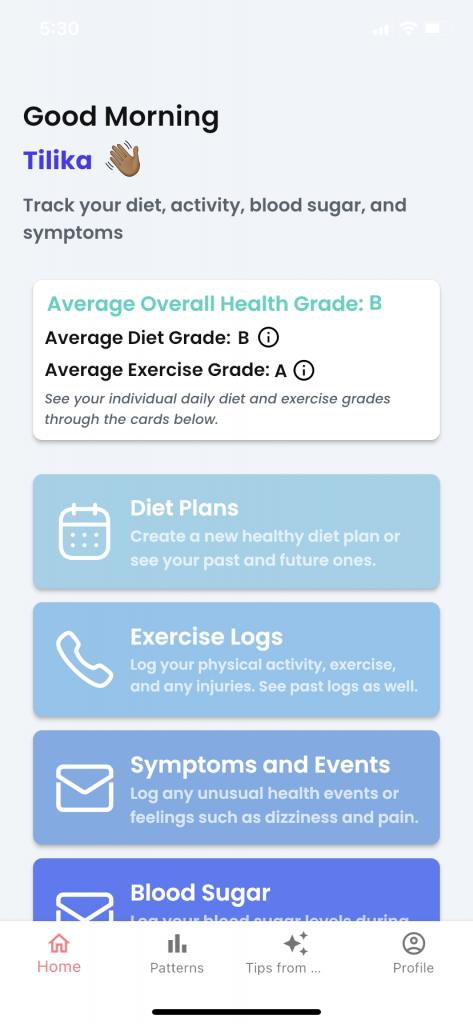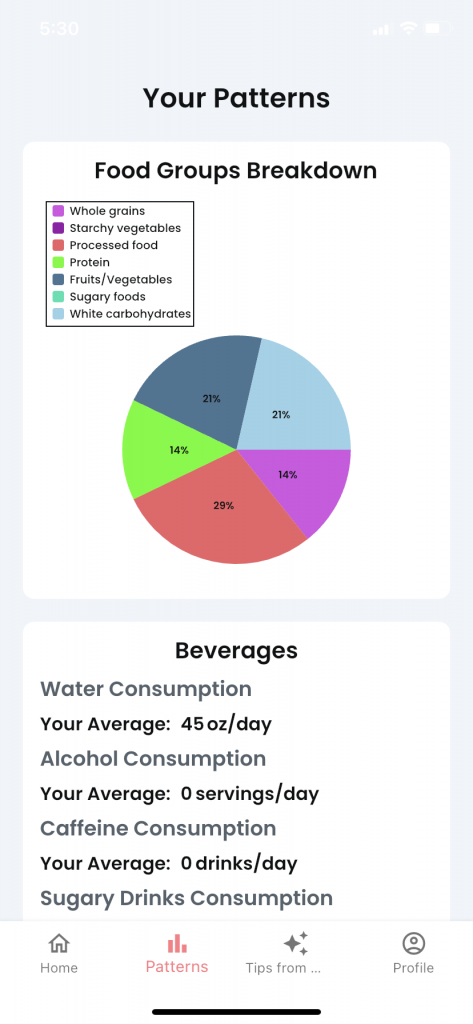Tilika Kulkarni, Applied Science
Abstract
Diabetes management is challenging and can pose significant problems for patients. Mobile health technologies, such as mobile apps, have shown potential in improving diabetes management and patient outcomes. However, existing apps often lack the capacity to provide personalized recommendations based on user data. This project aimed to develop an app to address these limitations and provide personalized recommendations to diabetic patients. The app was built using FlutterFlow and tested by two diabetic patients who provided feedback and recommendations. Results showed that the app effectively collected and displayed user data related to diet, exercise, and symptom tracking, and provided personalized recommendations based on the user’s input. The app offers a potential tool for individuals with diabetes to enhance their self-management and overall health.
Introduction
Diabetes is a chronic metabolic disorder that poses significant challenges to patients worldwide, including frequent monitoring of blood glucose levels, adherence to a strict diet, and regular exercise.
Mobile health technologies, such as mobile apps, can help improve diabetes management and patient outcomes. Research has shown that these apps can enhance self-management behaviors, improve glycemic control, and reduce the risk of diabetes complications (Huang et al., 2019; Liang et al., 2020). Moreover, mobile apps can provide patients with real-time feedback, personalized recommendations, and social support, which can enhance motivation and engagement (Liang et al., 2020). However, existing diabetes management apps often lack the capacity to provide personalized analysis and recommendations based on the user’s data (Goyal et al., 2020; Gomez-Marcos et al., 2019; Istepanian et al., 2018).
This app aims to address these limitations by providing an easy-to-use tool for diabetic patients to track their daily activities, monitor their blood glucose levels, and receive personalized recommendations based on their data. It features a food diary, exercise tracker, blood glucose monitor, and symptom tracker.
Materials and Methods
The app was developed using FlutterFlow, a web-based platform for building and deploying mobile and web applications. Integrated with FlutterFlow, Google Firebase, a cloud-based database system, allows for the storage and retrieval of user data in real-time. When the user inputs data into this app, the data is sent to Firebase, where it is stored and can be accessed by the app in real-time. Firebase provides a scalable and secure solution for data storage, making it an ideal choice for mobile app development. This allows for the app to provide personalized recommendations and insights based on the user’s data.
Two patients with diabetes were interviewed to identify the challenges they faced in managing their condition. The interviews revealed that managing diet, exercise, blood sugar levels, and symptoms were significant concerns for the patients. To address these concerns, the app was designed to allow users to input their daily diet, exercise regimen, blood sugar levels at different times of day, and symptoms. The app analyzes this data to provide recommendations for diet and exercise and to identify patterns in diet, exercise, symptoms, and blood sugar levels over time. Figure 2 shows a page of the app which provides a pie chart of the different food groups that the user eats on average; all the data collected about the user’s diet is used to construct the pie chart. Such patterns and data analysis shown to the user is updated every time the user enters new information. The app also provides grades for diet and exercise to encourage better habits: figure 1 shows the home page of the app which displays the user’s average diet grade and average exercise grade.

Figure 1. The Home Page of the App

Figure 2. (Diet) patterns displayed in the app
After the initial development phase, the app was tested by the same diabetic patients who provided recommendations, including the addition of a feature to track daily water intake. As a result, tracking water intake was included in the daily diet feature.
Results
The objective of this study was to develop an app that helps diabetic patients manage their condition by tracking their daily activities and symptoms, monitoring their blood glucose levels, and providing personalized recommendations based on their data.
To achieve this goal, the app was built to allow users to enter their daily diet, exercise, blood sugar levels, and symptoms. The app takes this data and gives recommendations for diet and exercise, and shows patterns in diet, exercise, symptoms, and blood sugar over time.
After building the first phase of the app, diabetic patients were asked to use and test the app for one week. They provided feedback and recommendations, one of which was to include a feature that helps users track their water intake. This feature was incorporated into the tracking of daily diet. The patients reported all the features of the app to be working as intended and reported making small changes to their daily diet after seeing the recommendations for diet and exercise.
Discussion
In summary, the app was designed to assist individuals with diabetes in managing their diet, exercise, blood sugar, and symptoms. Results from user testing indicated that the app effectively collected and displayed user data related to diet, exercise, and symptom tracking, and provided recommendations based on the user’s input. The recommendations follow general diet and exercise guidelines and are not specific to individual patients’ conditions, but are specific to the user’s input of their diet and exercise plans; two different users that enter the same data and diet would get the same recommendations.
Based on the study’s findings, the app has the potential to enhance diabetes self-management by providing personalized and actionable information. Nonetheless, there were limitations to the research, including the small sample size and short testing period. Moreover, while the app effectively collected user data, it remains uncertain whether the recommendations provided are sufficient for long-term behavioral changes.
In the future, a more comprehensive and longer-term study would be beneficial to further evaluate the app’s effectiveness in enhancing diabetes self-management. Additionally, integrating features such as medication and appointment reminders, as well as social support networks, may enhance the user experience and promote long-term app use. Overall, the app offers a potential tool for individuals with diabetes to enhance their self-management and overall health.
References
Goyal, S., Nunn, E., Rotondi, M., Couper, M. P., Rechtsteiner, E. A., & Thorpe, C. T. (2020). Diabetes mobile apps and HbA1c in type 2 diabetes: systematic review and meta-analysis. JMIR mHealth and uHealth, 8(9), e21758.
Huang, Z., Tao, H., Meng, Q., Jing, L., and Cai, M. “Mobile App-Based Interventions to Support Diabetes Self-Management: A Systematic Review of Randomized Controlled Trials to Identify Functions Associated with Glycemic Efficacy.” JMIR mHealth and uHealth, vol. 7, no. 3, 2019, article e12644, doi:10.2196/12644.
Istepanian, R. S., Zitouni, K., Harry, D., & Moutosammy, N. (2018). Evaluation of a mobile phone telemonitoring system for glycaemic control in patients with diabetes. Journal of Telemedicine and Telecare, 24(9), 609-616.
Liang, X., et al. “Effect of Mobile Health Interventions on Glycemic Control in Patients With Type 2 Diabetes: A Meta-analysis.” JMIR mHealth and uHealth, vol. 8, no. 1, 2020, e14833, doi: 10.2196/14833.